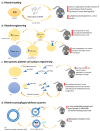Multifaceted Functions of Platelets in Cancer: From Tumorigenesis to Liquid Biopsy Tool and Drug Delivery System
- PMID: 33339204
- PMCID: PMC7765591
- DOI: 10.3390/ijms21249585
Multifaceted Functions of Platelets in Cancer: From Tumorigenesis to Liquid Biopsy Tool and Drug Delivery System
Abstract
Platelets contribute to several types of cancer through plenty of mechanisms. Upon activation, platelets release many molecules, including growth and angiogenic factors, lipids, and extracellular vesicles, and activate numerous cell types, including vascular and immune cells, fibroblasts, and cancer cells. Hence, platelets are a crucial component of cell-cell communication. In particular, their interaction with cancer cells can enhance their malignancy and facilitate the invasion and colonization of distant organs. These findings suggest the use of antiplatelet agents to restrain cancer development and progression. Another peculiarity of platelets is their capability to uptake proteins and transcripts from the circulation. Thus, cancer-patient platelets show specific proteomic and transcriptomic expression patterns, a phenomenon called tumor-educated platelets (TEP). The transcriptomic/proteomic profile of platelets can provide information for the early detection of cancer and disease monitoring. Platelet ability to interact with tumor cells and transfer their molecular cargo has been exploited to design platelet-mediated drug delivery systems to enhance the efficacy and reduce toxicity often associated with traditional chemotherapy. Platelets are extraordinary cells with many functions whose exploitation will improve cancer diagnosis and treatment.
Keywords: cancer development; drug delivery system; extracellular vesicles; platelet-derived molecules; platelets; tumor-educated platelets.
Conflict of interest statement
The authors declare no conflict of interest.
Figures
References
Publication types
MeSH terms
Substances
Grants and funding
LinkOut - more resources
Full Text Sources
Medical


